Submitted:
14 September 2023
Posted:
15 September 2023
You are already at the latest version
Abstract
Keywords:
1. Introduction
2. Research Methods
2.1. SWAT Hydrological Model
2.2. Drought Indexes
2.2.1. Standardized Precipitation Evapotranspiration Index
2.2.2. Standardized Soil Moisture Index
2.2.3. Nonlinear Joint Hydrological Drought Index
2.2.4. Classification Standard of Drought Grades
2.3. Drought Propagation Time
3. Case study and Data Sources
3.1. The Yellow River Basin
3.2. Data Sources
4. Results and Discussion
4.1. Simulation Results of SWAT Model
4.2. Propagation Time of Meteorological Drought to Agricultural Drought
4.3. Propagation Time of Agricultural Drought to Hydrological Drought
4.4 .Uncertainty Analysis
5. Conclusions
Author Contributions
Funding
Institutional Review Board Statement
Informed Consent Statement
Conflicts of Interest
References
- Bi, W.X .; Li, M; Weng, B.S. ; Yan, D.H.; Dong, Z.Y. ; Feng, J.M. ; Wang, H. Drought-flood abrupt alteration events over China[J]. Science of total environment. 2023, 875, 162529. [CrossRef]
- Pratt, R.B.; Jacobsen, A.L.; Ramirez, A.R.; Helms, A.M.; Traugh, C.A.; Tobin, M.F.; Heffner, M.S.; Davis, S.D. Mortality of resprouting chaparral shrubs after a fire and during a record drought: physiological mechanisms and demographic consequences. Global change biology. 2016, 20 (3):893-907. [CrossRef]
- Wang, Z.L.; Zhong, R.D.; Lai, C.G.; Zeng, Z.Y.; Lian, Y.Q.; Bai, X.Y. Climate change enhances the severity and variability of drought in the Pearl River Basin in South China in the 21st century. Agricultural & Forest Meteorology. 2018, 249:149-162. [CrossRef]
- Sun, P.; Liu, R.L.; Yao, R.; Shen, H.; Bian, Y.J. Responses of agricultural drought to meteorological drought under different climatic zones and vegetation types[J]. journal of hydrology,2023, 619, 129305. [CrossRef]
- Paez-Trujillo, A.; Corzo, G.A.; Maskey, S.; Solomatine, D. Model-Based Assessment of Preventive Drought Management Measures' Effect on Droughts Severity[J]. Water, 2023,15 (8),1442. [CrossRef]
- Chen, N.; Li, R.; Zhang, X.; Yang, C.; Wang, X.; Zeng, L.; Tang, S.; Wang, W.; Li, D.; Niyogi, D. Drought propagation in Northern China Plain: A comparative analysis of GLDAS and MERRA-2 datasets. Journal of Hydrology. 2020a, 588: 125026. [CrossRef]
- Zhang, H.; Ding, J.; Wang, Y.S.; Zhou, D.Y.; Zhu, Q. Investigation about the correlation and propagation among meteorological, agricultural and groundwater droughts over humid and arid/semi-arid basins in China. Journal of Hydrology. 2021, 603:127007. [CrossRef]
- Yuan, X.; Ma, F.; Li, H.; Chen, S.S. A review on multi-scale drought processes and prediction under global change. Trans Atmos Sci,2020a, 43(1):225-237 (In Chinese with English Abstract).
- Wang, M.H.; Jiang, S.H.; Ren, L.L.; Xu, C.Y.; Menzel, L.; Yuan, F.; Xu, Q.; Liu, Y.; Yang, X.L. Separating the effects of climate change and human activities on drought propagation via a natural and human-impacted catchment comparison method. Journal of Hydrology. 2021, 603:126913. [CrossRef]
- Li, Y.F.; Huang, S.Z.; Wang, H.Y.; Zheng, X.D.; Huang, Q.; Deng, M.J. High-resolution propagation time from meteorological to agricultural drought at multiple levels and spatiotemporal scales. Agricultural Water Management. 2022, 262, 107428. [CrossRef]
- Huang, S. Z.; Li, P.; Huang, Q.; Leng, G.Y.; Hou, B.B.; Ma, L. The propagation from meteorological to hydrological drought and its potential influence factors. Journal of Hydrology. 2017, 547: 184–195. [CrossRef]
- Wu, J. F.; Chen, X. H.; Yao, H.X.; Liu, Z.Y.; Zhang, D.J. Hydrological Drought Instantaneous Propagation Speed Based on the Variable Motion Relationship of Speed-Time Process. Water Resources Research. 2018, 54(11): 9549-9565. [CrossRef]
- Xing, Z.K.; Ma, M.M.; Zhang, X.J.; Leng, G.Y.; Su, Z.C.; Lv, J.; Yu, Z.B.; Yi, P. Altered drought propagation under the influence of reservoir regulation. Journal of Hydrology. 2021, 603, 127049. [CrossRef]
- Xu, Z.G.; Wu, Z.Y.; Shao, Q.X.; He, H.; Guo, X. From meteorological to agricultural drought: Propagation time and probabilistic linkages. JOURNAL OF HYDROLOGY-REGIONAL STUDIES. 2023, 46, 101329. [CrossRef]
- Ma, F.; Luo, L.F.; Ye, A.Z.; Duan, Q.Y. Drought Characteristics and Propagation in the Semiarid Heihe River Basin in Northwestern China. Journal of Hydrometeorology. 2019, 20(1): 59-77. [CrossRef]
- Li, R.H.; Chen, N.C.; Zhang, X.; Zeng, L.L.; Wang, X.P.; Tang, S.J.; Li, D.R.; Niyogi, D. Quantitative analysis of agricultural drought propagation process in the Yangtze River Basin by using cross wavelet analysis and spatial autocorrelation. Agricultural and Forest Meteorology. 2020, 280,107809. [CrossRef]
- Liu, Y.J.; Huang, S.Z.; Fang, W.; Ma, L.; Zhang, X.D.; Huang, Q. Propagation and dynamic change of meteorological drought to hydrological drought in different seasons. Shuili Xuebao. 2021, 52(1): 93-102. (In Chinese with English Abstract).
- Bai, M.; Li, Z.L.; Huo, P.Y.; Wang, J.W.; Li, Z.J. Propagation characteristics from meteorological drought to agricultural drought over the Heihe River Basin, Northwest China. Journal of arid land. 2023, 151(5): 523-544. [CrossRef]
- Dash, S.S.; Sahoo, B.; Raghuwanshi, N.S. A SWAT-Copula based approach for monitoring and assessment of drought propagation in an irrigation command. Ecological Engineering. 2018, 127:417-430. [CrossRef]
- Li, Q.F.; He, P.F.; He, Y.C.; Han, X.Y.; Zeng, T.S.; Lu, G.B.; Wang, H.J. Investigation to the relation between meteorological drought and hydrological drought in the upper Shaying River Basin using wavelet analysis. Atmospheric Research. 2020, 234, 104743. [CrossRef]
- Zhang, Y.; Hao, Z.C.; Feng, S. F.; Zhang, X.; Xu, Y.; Hao, F.H. Agricultural drought prediction in China based on drought propagation and large-scale drivers. Agricultural water management. 2021, 255, 107028. [CrossRef]
- Bhatta, B.; Shrestha, S.; Shrestha, P.K.; Talchabhadel, R. Evaluation and application of a SWAT model to assess the climate change impact on the hydrology of the Himalayan River Basin. Catena. 2019, 181: 104082. [CrossRef]
- Frederiksen, R.R.; Molina-Navarro, E. The importance of subsurface drainage on model performance and water balance in an agricultural catchment using SWAT and SWAT-MODFLOW. Agricultural water management. 2021, 255, 107058. [CrossRef]
- Li, Y.Y.; Chang, J.X.; Wang, Y.M.; Jin, W.T.; Guo, A.J. Spatiotemporal Impacts of Climate, Land Cover Change and Direct Human Activities on Runoff Variations in the Wei River Basin, China. Water. 2016, 8, 220. [CrossRef]
- Liu, R.; Wang, Q.; Fei, X.; Cong, M.; Guo, L. Impacts of manure application on swat model outputs in the xiangxi river watershed. Journal of Hydrology. 2017, 555: 479-488. [CrossRef]
- Femeena, P.V.; Chaubey, I.; Aubeneau, A.; McMillan, S.K.; Wagner, P.D.; Fohrer, N. An improved process-based representation of stream solute transport in the soil and water assessment tools. Hydrological process. 2020, 34(11):2599-2611. [CrossRef]
- Fathian, F.; Ahmadzadeh, H.; Mansouri, B.; Vaheddoost, B. Assessment of water demand reliability using SWAT and RIBASIM models with respect to climate change and operational water projects. Agricultural Water Management. 2022, 261: 107377. [CrossRef]
- Nash, J. E.; Sutcliffe, J.V. River flow forecasting through conceptual models, part I-a discussion of principles. Journal of Hydrology. 1970, 10(3): 282-290. [CrossRef]
- Gupta, H.; Sorooshian, S.; Yapo, P. Status of automatic calibration for hydrologic models: comparison with multilevel expert calibration. Journal of Hydrology Engineering. 1999, 4(2): 135-143. [CrossRef]
- Ashok, K.M.; Vijay, P.S. A review of drought concepts. Journal of Hydrology. 2010, 391(1): 202-216.
- Bae, S.; Lee, S.H.; Yoo, S.H.; Kim, T. Analysis of drought intensity and trends using the modified SPEI in south korea from 1981 to 2010. 2018, Water, 10(3): 327. [CrossRef]
- Vicente-Serrano, S. M.; Beguería, S.; López-moreno, J.I. A multiscalar drought index sensitive to global warming: the standardized precipitation evapotranspiration index. Journal of Climate. 2010, 23(7): 1696-1718. [CrossRef]
- Imran, K. M.; Zhu, X.Y.; Muhammad, A. Assessment of spatiotemporal characteristics of agro-meteorological drought events based on comparing Standardized Soil Moisture Index, Standardized Precipitation Index and Multivariate Standardized Drought Index. Journal of Water and Climate Change. 2020, 11( S1): 1-17.
- Carrão, H.; Russo, S.; Sepulcre-Canto, G. An empirical standardized soil moisture index for agricultural drought assessment from remotely sensed data. International Journal of Applied Earth Observation and Geoinformation. 2016, 48: 74-84. [CrossRef]
- Zhai, J.Q.; Jiang, G.Q.; Pei, Y.S.; Zhao, Y.; Xiao, W.H. Hydrological drought assessment in the river basin based on Standard Water Resources Index (SWRI): a case study on the Northern Haihe River. Shuili Xuebao. 2015, 46(6): 687-698. (In Chinese with English Abstract).
- Li, Y. Y.; Luo, L.F.; Chang, J.X.; Wang, Y.M.; Guo, A.J.; Fan, J.J.; Liu, Q. Hydrological drought evolution with a nonlinear joint index in regions with significant changes in underlying surface. Journal of Hydrology. 2020, 585, 124794. [CrossRef]
- Li, R.H.; Chen, N.C.; Zhang, X.; Zeng, L.L.; Wang, X.P.; Tang, S.J.; Li, D.R.; Niyogi, D. Quantitative analysis of agricultural drought propagation process in the Yangtze River Basin by using cross wavelet analysis and spatial autocorrelation. Agricultural and Forest Meteorology. 2020, 280,107809. [CrossRef]
- Wu, H.; Su, X.; Singh, V. P.; Feng, K.; Niu, J. Agricultural drought prediction based on conditional distributions of vine copulas. Water Resources Research. 2021, 57(8), e2021WR029562. 8. [CrossRef]
- Chen, S.H.; Liu, Y.; Liu, Z.; Cao, L.S.; Yu, Y.C. ; Zhou,Y. Temporal and spatial characteristics of drought in the Jinghe River Basin in the past 50 years based on the SPEI index. Journal of soil and water conservation. 2022c, 36(2):181-188,196.
- Pena-Gallardo, M.; Vicente-Serrano, S.M.; Hannaford, J.; Lorenzo-Lacruz, J.; Svoboda, M. Dominguez-Castro, F., Maneta, M., Tomas-Burguera, M., El Kenawy, A. Complex influences of meteorological drought time-scales on hydrological droughts in natural basins of the contiguous Unites States. Journal of Hydrology. 2018, 568: 611-625. [CrossRef]
- Chen, N.C.; Li, R.H.; Zhang, X.; Yang, C.; Wang, X.P.; Zeng, L.L.; Tang, S.J.; Wang, W.; Li, D.R.; Niyogi, D. Drought propagation in Northern China Plain: A comparative analysis of GLDAS and MERRA-2 datasets. Journal of Hydrology. 2020b, 588: 125026. [CrossRef]
- Zhang, Y.; Hao, Z.C.; Feng, S. F.; Zhang, X.; Xu,Y.; Hao, F.H. Agricultural drought prediction in China based on drought propagation and large-scale drivers. Agricultural water management. 2021, 255, 107028. [CrossRef]
- Liu, Q.; Yang, Y.T.; Liang, L.Q.; Jun, H.; Yan, D.H.; Wang, X.; Li, C.H.; Sun, T. Thresholds for triggering the propagation of meteorological drought to hydrological drought in water-limited regions of China. Science of total environment. 2023, 876, 162771. [CrossRef]
- Zheng, Y.T.; Huang, Y.F.; Zhou, S.; Wang, K.Y.; Wang, G.Q. Effect partition of climate and catchment changes on runoff variation at the headwater region of the Yellow River based on the Budyko complementary relationship. Science of The Total Environment. 2018, 643:1166-1177. [CrossRef]
- Yuan, M.X.; Wang, L.C.; Lin, A.W.; Liu, Z.J.; Li, Q.J.; Qu, S. Vegetation green up under the influence of daily minimum temperature and urbanization in the Yellow River Basin. China. Ecological Indicators. 2020b, 108:105760. [CrossRef]
- Li, Y. Y.; Luo, L.F.; Chang, J.X.; Wang, Y.M.; Guo, A.J.; Fan, J.J.; Liu, Q. Hydrological drought evolution with a nonlinear joint index in regions with significant changes in underlying surface. Journal of Hydrology. 2020c, 585, 124794. [CrossRef]
- Chang, J.X.; Li, Y.Y.; Wang, Y.M.; Yuan, M. Copula-based drought risk assessment combined with an integrated index in the Wei River Basin, China. Journal of Hydrology. 2016, 540: 824-834.
- Wang, F.; Wang, Z.M.; Yang, H.B.; Di, D.Y.; Zhao, Y.; Liang, Q.H.; Hussain, Z. Comprehensive evaluation of hydrological drought and its relationships with meteorological drought in the Yellow River basin, China. Journal of Hydrology. 2020, 584, 124751. [CrossRef]
- Hu, C.H.; Ran, G.; Li, G.; Yu, Y.; Jian, S. The effects of rainfall characteristics and land use and cover change on runoff in the yellow river basin, china. Journal of Hydrology and Hydromechanics. 2021, 69(1): 29-40. [CrossRef]
- Xu, Z.; Zhang, S.; Yang, X. Water and sediment yield response to extreme rainfall events in a complex large river basin: a case study of the yellow river basin, china. Journal of Hydrology. 2021, 597(2), 126183. 2. [CrossRef]
- Tao, G. ; Si,Y.; Wei, Y.; Lian, G.; Xiao, S. Typical synoptic types of spring effective precipitation in inner mongolia, china. Meteorological Applications. 2014, 21(2):330-339.
- Omer, A.; Ma, Z.; Zheng, Z.; Saleem, F. Natural and anthropogenic influences on the recent droughts in Yellow River Basin, China. Science of the Total Environment. 2020, 704: 135428. [CrossRef]
- Liang, W.; Bai, D.; Wang, F.; Fu, B.; Yan, J.; Wang, S.; Yang, Y.; Long, D.; Feng, M. Quantifying the impacts of climate change and ecological restoration on streamflow changes based on a Budyko hydrological model in China's loess plateau. Water Resources Research. 2015, 51: 6500–6519.
- Chang, J.X.; Li, Y.Y.; Yuan, M.; Wang, Y. M. Efficiency evaluation of hydropower station operation: a case study of longyangxia station in the yellow river, china. Energy. 2017, 135: 23-31. [CrossRef]
- Xing, Z.X.; Wang, L.J.; Wang, X.; Fu, Q.; Ji, Y.; Li, H.; Liu, Y.J. The study on equifinality of hydrological model parameters and runoff simulation based on the improved simulation-optimization algorithm. Journal of basic science and engineering. 2020, 28(5):1091-1107.
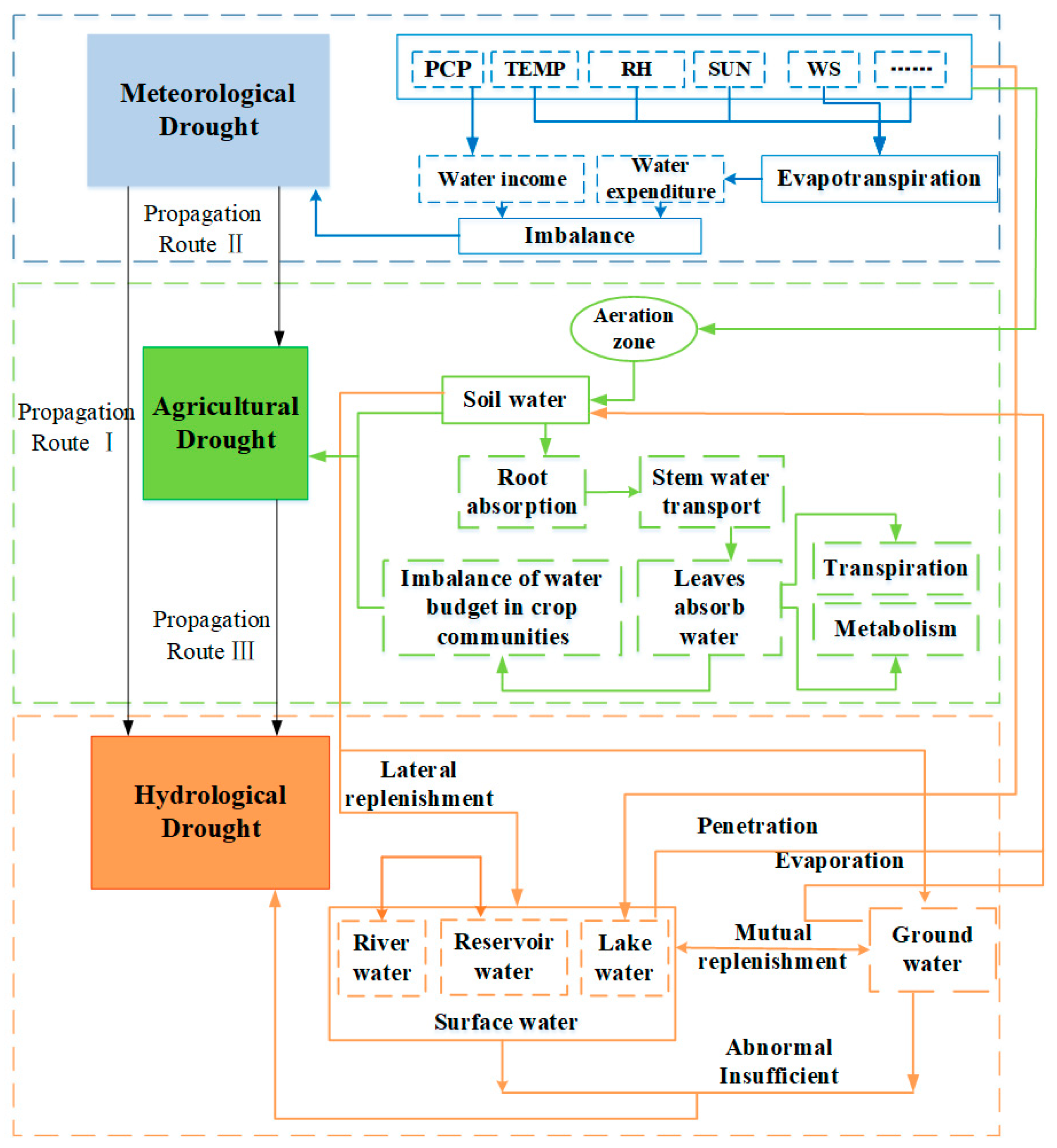

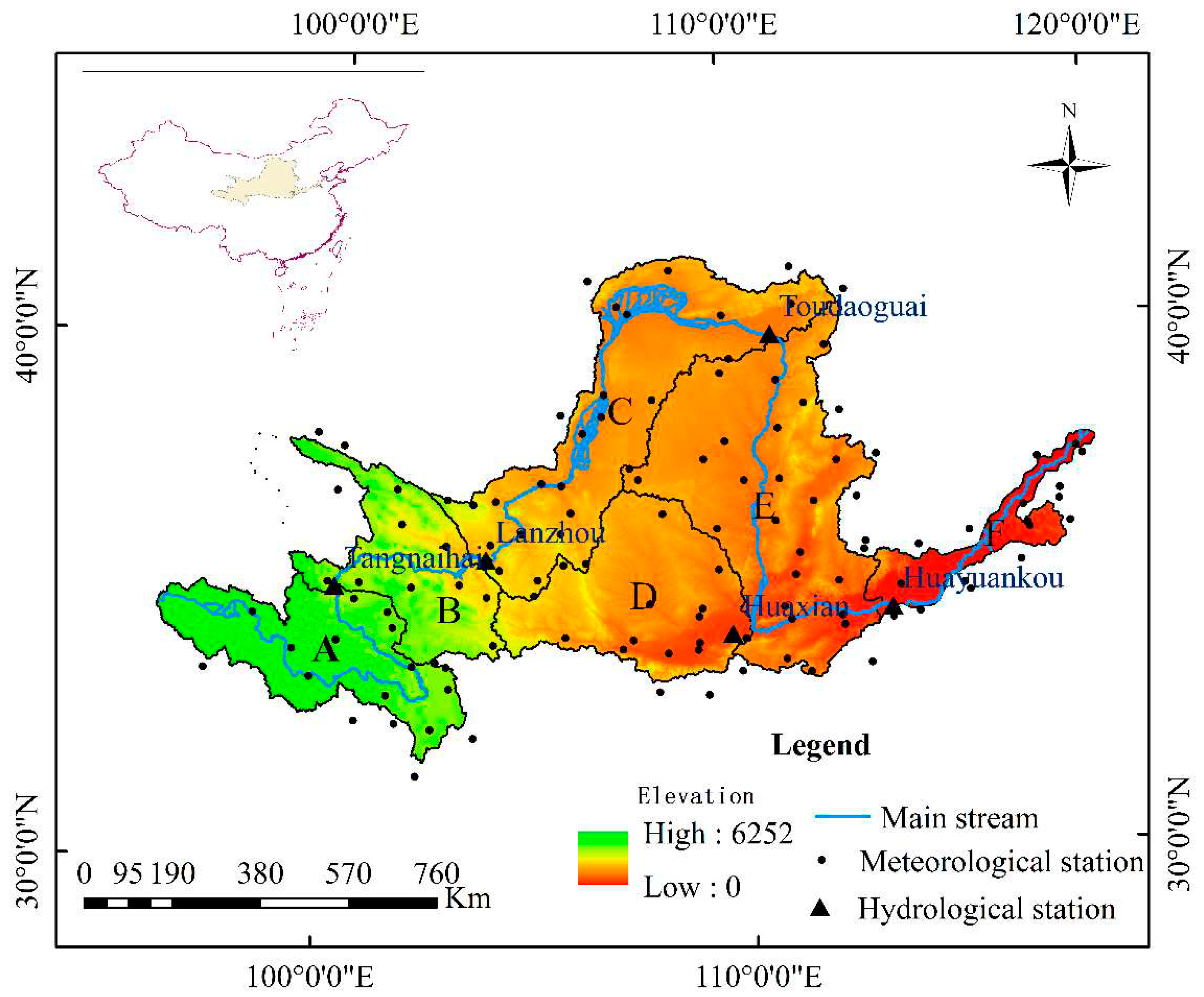
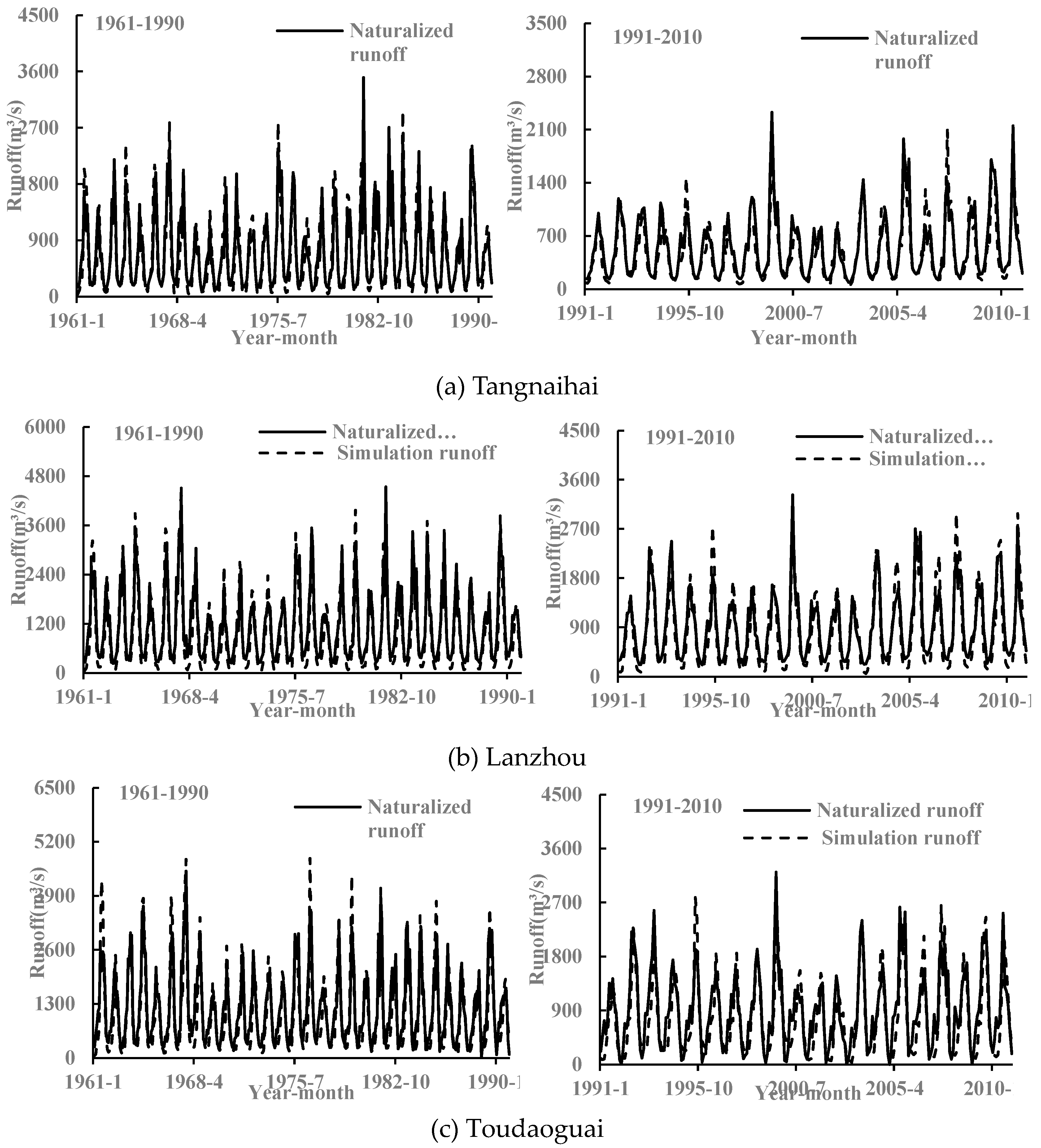
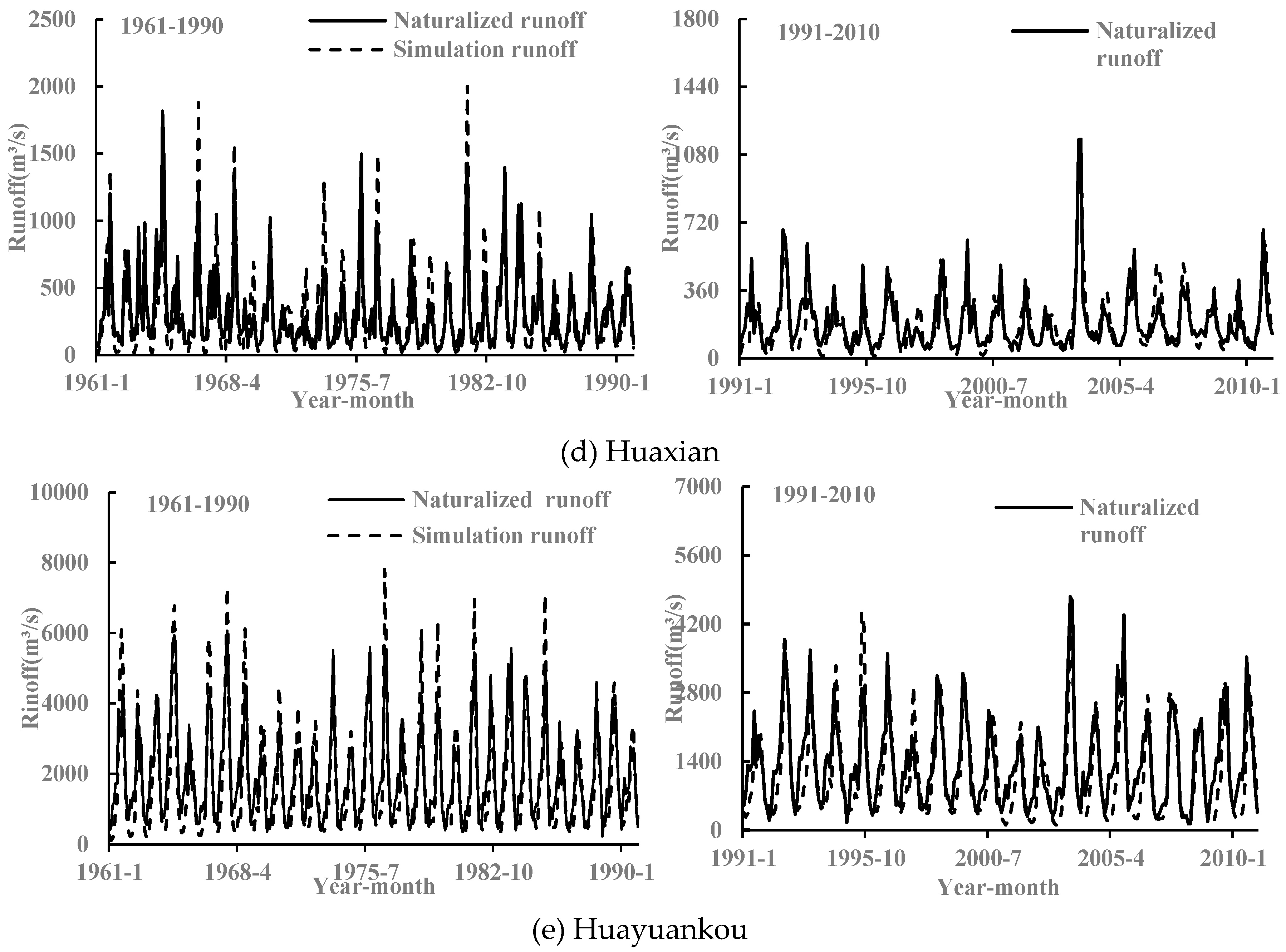
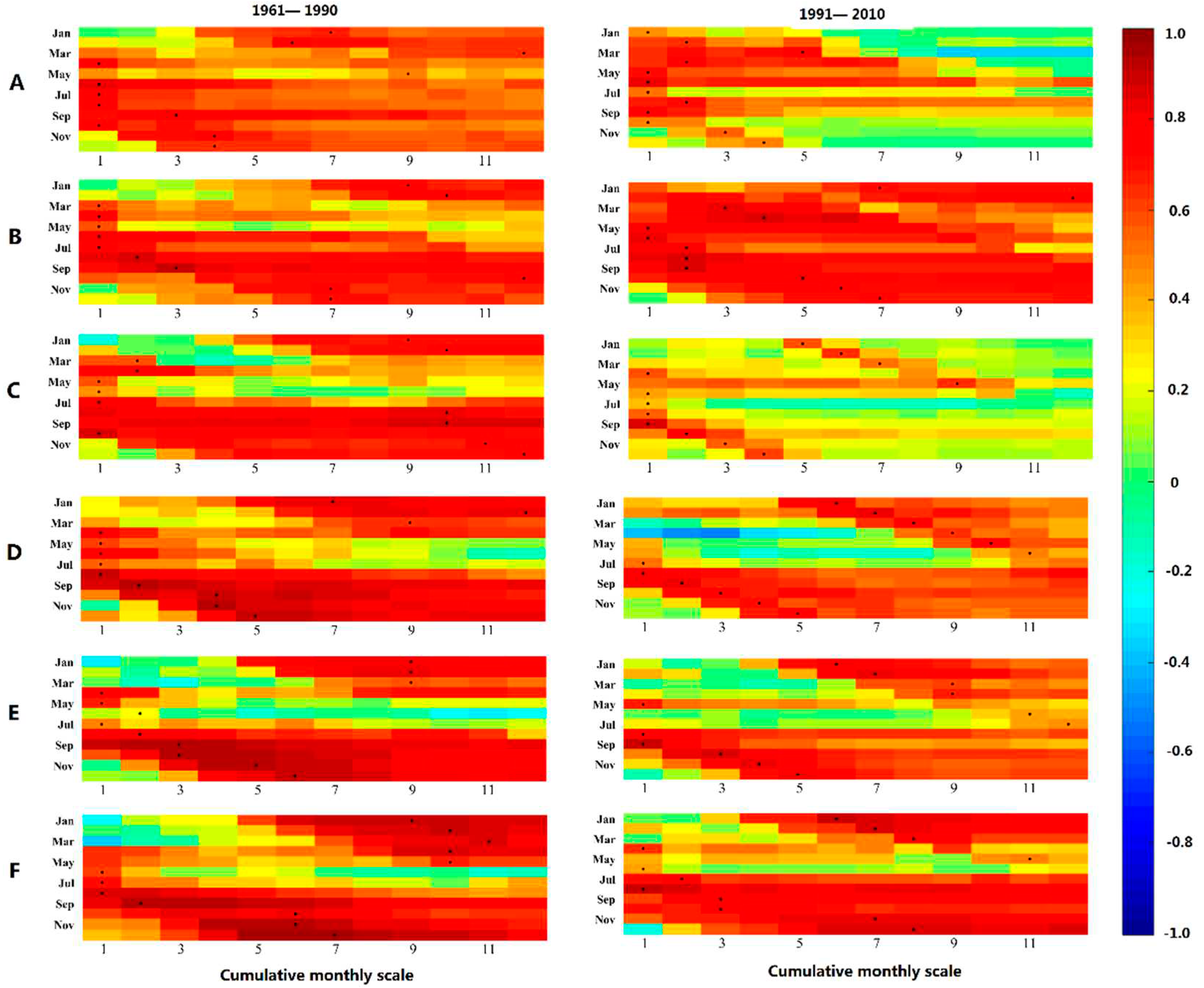
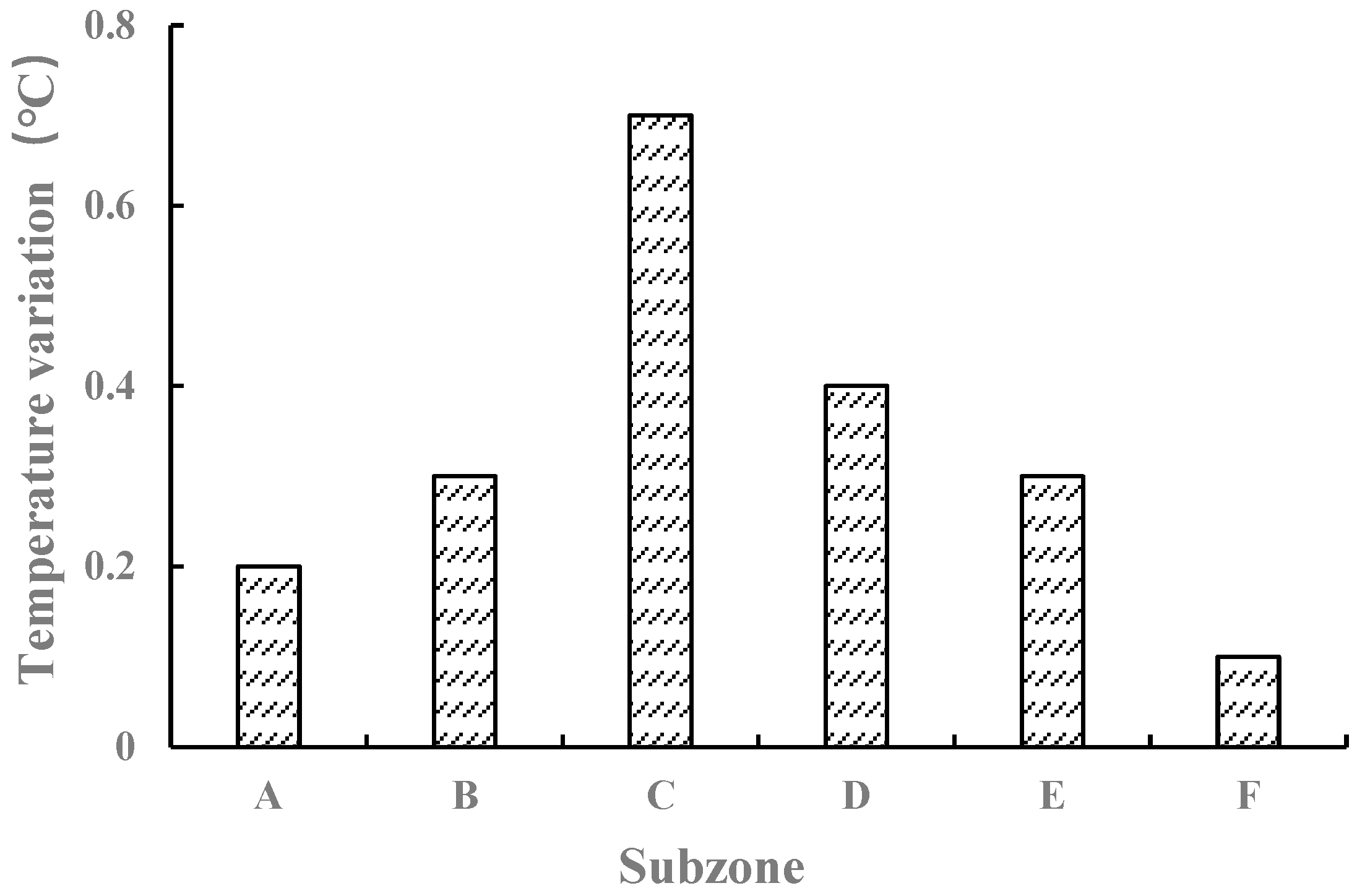
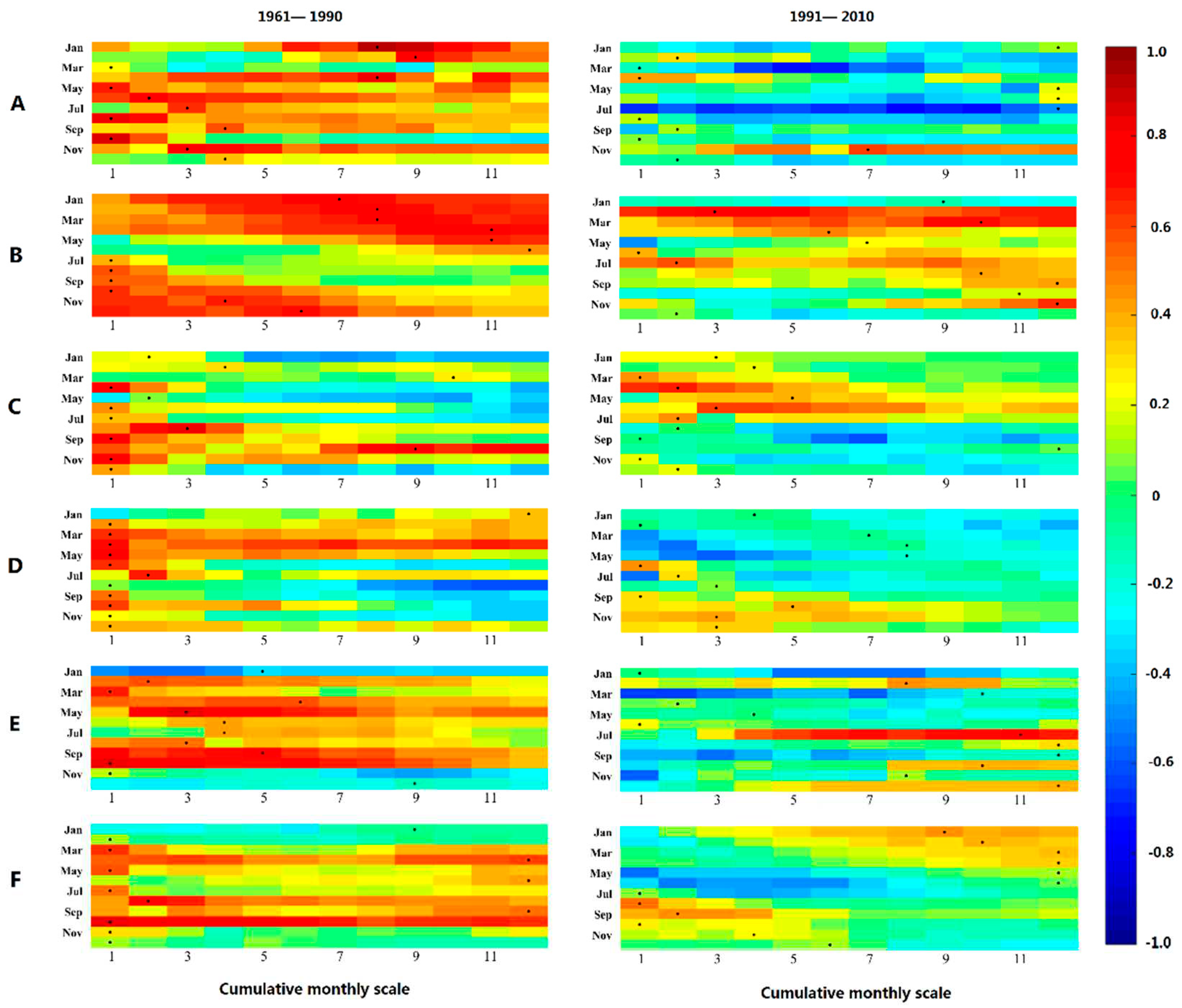
| Drought grade | Meteorological drought | Agricultural drought | Hydrological drought |
|---|---|---|---|
| No drought | |||
| Light drought | |||
| Medium Drought | |||
| Severe drought | |||
| Extreme drought |
| Period | Warm-up period | Calibration period | Verification period |
|---|---|---|---|
| 1961-1990 | 1960 | 1961-1975 | 1976-1990 |
| 1991-2010 | 1990 | 1991-2000 | 2001-2010 |
| Period | Spring | Summer | ||||||||||||
|---|---|---|---|---|---|---|---|---|---|---|---|---|---|---|
| A | B | C | D | E | F | Whole basin | A | B | C | D | E | F | Whole basin | |
| Period | Autumn | Winter | ||||||||||||
| A | B | C | D | E | F | Whole basin | A | B | C | D | E | F | Whole basin | |
| 1961—1990 | 7 | 1 | 2 | 4 | 4 | 10 | 5 | 1 | 1 | 4 | 1 | 2 | 1 | 2 |
| 1991—2010 | 3 | 3 | 6 | 9 | 6 | 7 | 6 | 1 | 2 | 1 | 4 | 4 | 1 | 3 |
| 1961—1990 | 3 | 6 | 6 | 4 | 4 | 5 | 5 | 6 | 9 | 10 | 8 | 8 | 9 | 8 |
| 1991—2010 | 2 | 4 | 3 | 3 | 3 | 4 | 3 | 4 | 8 | 5 | 6 | 6 | 7 | 6 |
| Period | Change area(km2) | Change proportion(%) |
|---|---|---|
| 1980—1990 | 898 | 5.16 |
| 1990—2000 | 1669 | 9.12 |
| 2000—2010 | 3980 | 19.93 |
Disclaimer/Publisher’s Note: The statements, opinions and data contained in all publications are solely those of the individual author(s) and contributor(s) and not of MDPI and/or the editor(s). MDPI and/or the editor(s) disclaim responsibility for any injury to people or property resulting from any ideas, methods, instructions or products referred to in the content. |
© 2023 by the authors. Licensee MDPI, Basel, Switzerland. This article is an open access article distributed under the terms and conditions of the Creative Commons Attribution (CC BY) license (http://creativecommons.org/licenses/by/4.0/).




